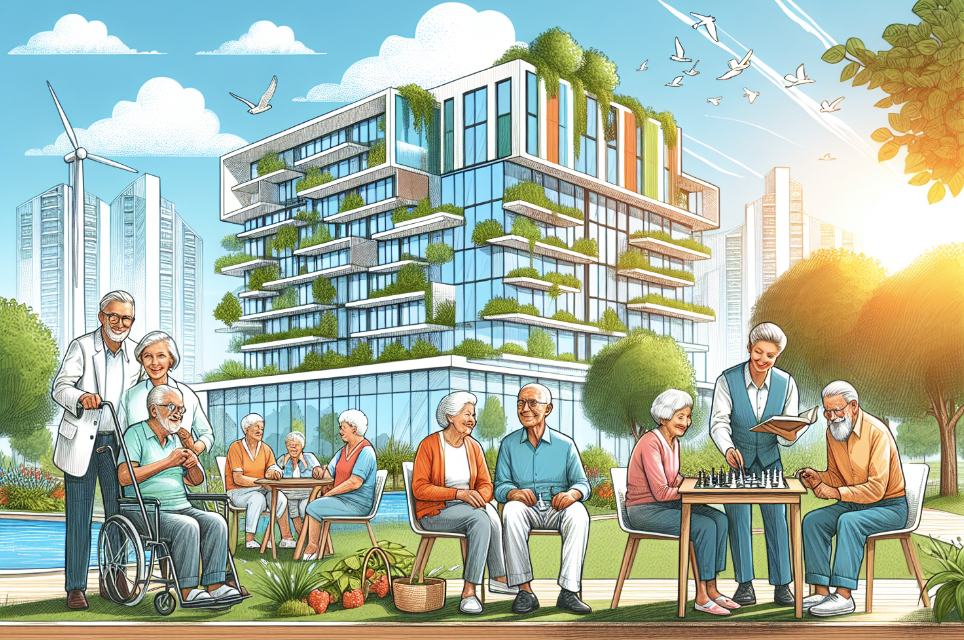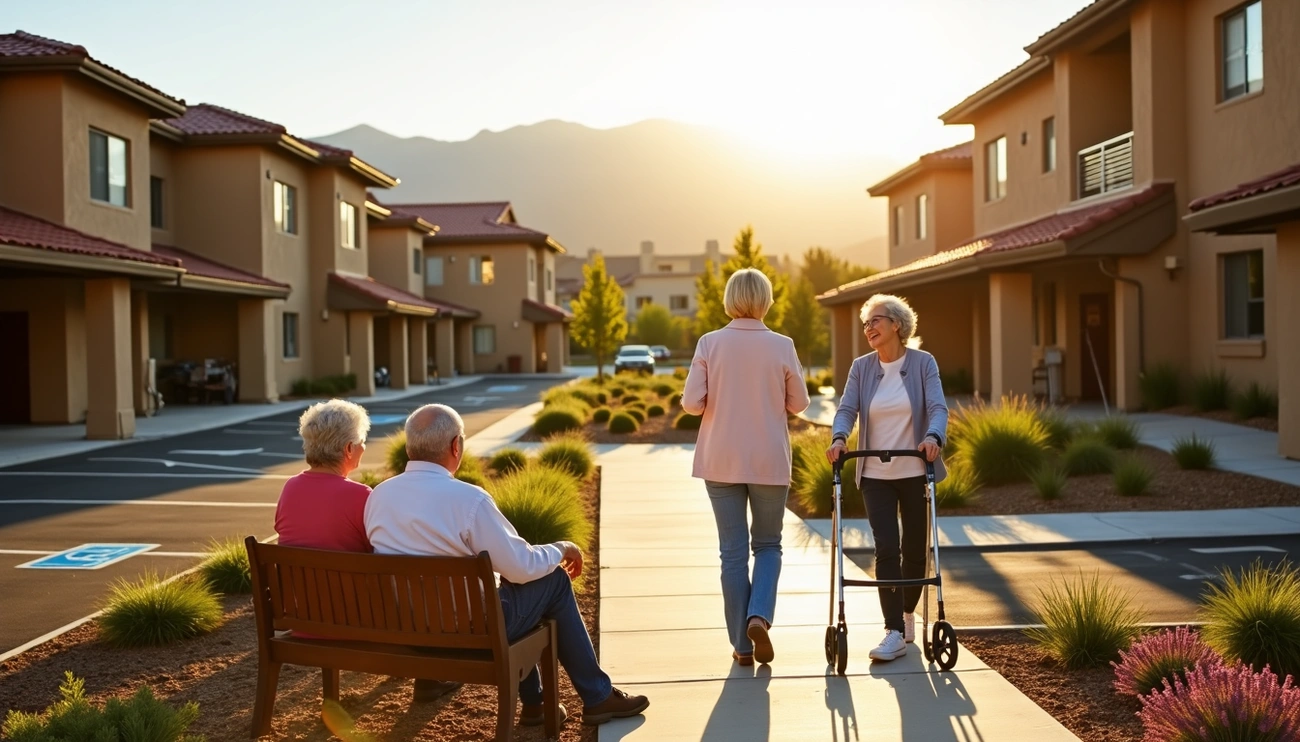The senior housing market is experiencing a significant transformation driven by technological advancements, shifting demographics, and a growing demand for high-quality care 4. As the number of people aged 65 or older worldwide is projected to more than double by 2050, rising from 761 million in 2021 to 1.6 billion, the senior living sector is poised to face new challenges and opportunities in 2024 2 4. With declining birthrates and changes in family structures resulting in fewer people available to support aging adults, assisted living is predicted to become the most prevalent senior care option, surpassing independent living 1 4.
In this comprehensive guide, we will explore the key senior housing trends for 2024, including the rise of tech-enhanced senior living, green and sustainable living options, adaptations to the new norm post-COVID-19, affordable housing solutions, and the evolving landscape of senior community amenities. We will also delve into the investment and market outlook for the senior housing sector, examining the potential for occupancy rates to regain pre-pandemic levels and the growing popularity of luxury senior living among affluent baby boomers 1 2.
The Rise of Tech-Enhanced Senior Living
The senior living industry is undergoing a technological revolution, with innovation and evolution continuing to transform the sector 2. Smart home technologies, such as voice-activated devices and advanced safety systems, are increasingly being integrated into senior living communities, enhancing the quality of life for residents 5. These technologies, along with virtual and augmented reality, are being used to enhance social connections, provide virtual travel and exploration opportunities, offer therapeutic applications, and deliver educational experiences 6.
Key technologies driving the advancement of senior living include:
- Robotics for cleaner environments and improved health: Autonomous cleaning solutions, like Cobi 18 by ICE Cobotics, help offset labor challenges and ensure high-touch areas are regularly cleaned, sanitized, and disinfected 4.
- Internet of Things (IoT) for enhanced safety and monitoring: Smart sensors, wearable devices, and connected appliances enable real-time monitoring of residents’ vital signs, movement, and activities, offsetting labor challenges 4.
- Telehealth and remote care services for easier medical assistance: These services make it easier for seniors to access necessary care, especially for those with mobility issues or difficulty traveling 4.
- AI-powered healthcare assistants: These assistants can monitor and assist residents, as well as power communication tools and devices that help connect residents based on similarities and personal preferences 4.
- Robotics for daily assistance and companionship: Robotic caregivers can help with tasks like medication management, meal preparation, and housekeeping 4.
- Augmented and Virtual Reality (AR/VR) for cognitive engagement: AR and VR technologies can help stimulate memory and increase cognitive functions in older residents 4.
- Smart environmental controls for added safety and comfort: WIFI-enabled technologies provide residents with greater control over their environment, making their living space more comfortable and easier to adjust 4.
Senior living facilities are adopting these modern technologies to keep residents connected, engaged, and safe 7. As the industry continues to evolve, the integration of cutting-edge technologies will become increasingly crucial in meeting the changing needs and expectations of the growing senior population.
Green and Sustainable Living Options
Green initiatives are becoming increasingly popular across various industries, including senior living facilities 8. Many communities are shifting towards solar panels and other clean energy sources to power their units, reducing residents’ monthly electric bills 8. Environmentally friendly and recyclable building materials, such as wood, brick, and glass, are being used in the construction of these facilities 8. Passive and active resource caching systems, such as rainwater harvesting, enable residents to collect and use water for various purposes 8.
Other sustainable features in senior living communities include:
- Low-flow water fixtures: Over 45% of water use in an average American household occurs in the bathroom. By installing low-flow fixtures, communities can minimize water waste and lower utility costs 8.
- LEED certification: LEED is a globally recognized rating system granted by the Green Building Certification Institute 8.
- Access to green spaces: Sustainable communities provide access to wider green spaces, which positively impact residents’ health 8.
- Strong sense of community: Living in a green community can foster shared values around sustainability, leading to more social opportunities and a reduced sense of loneliness among seniors 8.
Examples of top sustainable senior living communities in the US include Dancing Rabbit Ecovillage (Missouri), Sawyer Hill EcoVillage (Massachusetts), and EcoVillage at Ithaca (New York) 8. Residents can participate in community gardening, advocate for renewable energy adoption, engage in local sustainability groups and initiatives, and eat locally to contribute to a more sustainable lifestyle 9. Lutheran Social Ministries of Maryland has implemented measures to reduce food waste and lower the carbon footprint at its facilities 10. Sustainable living is a significant trend in 2024, with a focus on healthy home improvements, indoor air quality, kitchen upgrades, smart-home technology integration, energy-efficient improvements, and sustainable design 11.
Seabury’s Green Initiatives include solar panels, community gardens, alternative energy sources, energy-efficient light fixtures, low-flow water fixtures, recycling and composting programs, sustainable sources, and reduced disposable products 12. Aegis Living Lake Union in Washington State meets the guidelines of the Living Building Challenge (LBC), focusing on seven performance areas: Place, Water, Energy, Health and Happiness, Materials, Equity, and Beauty 13. Blue Mountain Construction is designing spaces that promote healthy living, with amenities that encourage physical activity, mental engagement, and social interaction 5. They are also responding by developing living spaces that are aesthetically pleasing, functional, and adaptable, catering to a range of needs from independent living to more specialized care 5.
Adaptation to the New Norm Post-COVID-19
As the senior living industry heads into 2024, it is gaining momentum on occupancy and is expected to regain pre-pandemic census levels by the end of the year 2. However, many of the same challenges that executives hoped to pivot away from in 2023 remain, including staffing, occupancy, and margins 14. Despite these ongoing issues, several senior living providers are adapting to the new norm post-COVID-19:
- Brookdale Senior Living introduced Brookdale HealthPlus, a new model of care coordination in assisted living, resulting in lower urgent care visits and hospitalizations for residents 14.
- 12 Oaks Senior Living celebrated a 16.5 percentage point increase in occupancy, aiming for an 85%+ average occupancy in 2024 14.
- Staffing concerns have moderated, with the expectation of a restoration to normal scheduling and overtime waning in 2024 14.
- Margins are expected to restore in 2024, albeit not quite to pre-pandemic levels, as market demand and supply achieve equilibrium 14.
- Solera Senior Living is pursuing a patient growth strategy, focusing on process improvements, revenue optimization, and technology adoption 14.
- The Springs Living expects NOI CAGR growth to 4% by the end of 2024, with a bright future but not for everyone due to consolidation 14.
- Pegasus Senior Living is focused on independent living through to assisted living and memory care, with a trend towards residents coming in with higher needs 14.
- Greystar anticipates a promising year ahead in 2024, with growth in third-party management and an innovative approach to centralize the assistant community manager role 14.
The COVID-19 pandemic has also led to a decline in demand for nursing homes and an increase in seniors preferring to age in place 15. As a result, the U.S. home healthcare market is expected to grow from $96.08 billion in 2023 to $156.28 billion by 2030 15. Companies like A Place At Home, which offer personalized care plans to fit the needs and price points of families, are thriving in the in-home care industry 15.
Senior living facilities are increasingly being designed to foster connections with the local community and accommodate aging in place 7. University-based senior living communities are an emerging trend, providing opportunities for seniors to take classes, teach, and mentor students 7. However, the senior living sector is facing financial struggles due to high construction costs, high interest rates, and lending uncertainty 7. To adapt, owners and developers are embracing the trend of adaptive reuse, converting empty or underused office buildings into senior living facilities 7. Senior housing occupancy is expected to reach pre-pandemic levels in the second half of 2024, with demand strong and the market continuing to recover 16 2.
Affordable Housing Solutions
With approximately 30,600 assisted living communities in the US providing nearly 1.2 million licensed beds, the demand for affordable senior housing is on the rise due to economic uncertainty and an aging population 8 18. The affordability crisis is evident, with 15 million older adults age 65-plus living at or below 200% of the federal poverty level 18. Despite consistent growth in senior housing occupancy rates over the past nine quarters, year-over-year inventory growth is only 1.3%, indicating a significant demand-supply gap 18.
To address this issue, federal, state, and local governments are taking action to preserve existing inventory and facilitate the construction of new senior housing 18. The 2024 President’s Budget requests $1.023 billion for Housing for the Elderly (Section 202), which will fully fund the approximately 1,18,205 units covered by the 2,868 contracts requiring renewal or amendment through December 2024 19. The budget also includes funding for Service Coordinator/Congregate Housing Services grants, Capital Advance Expansion, and Capital Advance Amendments and Other Expenses 19.
Affordable senior housing options in 2024 include 17:
- Low-Income Senior Apartments and Condos: Rent is typically no more than 30% of the adjusted gross income (AGI).
- Cooperative Housing for Seniors: Members purchase shares in the company and pay a monthly fee for the master mortgage, taxes, utilities, maintenance, repairs, etc.
- HUD Housing Programs: Section 8 Housing Choice Vouchers, Section 202 Supportive Housing for the Elderly.
- Virtual Retirement Communities: Seniors can save money on housing by choosing to stay in their own homes and becoming a member of a local virtual retirement community.
- Adult Family Homes or Adult Foster Care: Older adults are provided with assistance with daily needs, housing, meals, and social activities.
- Move in With Family: Living with family is a free or low-cost option for seniors.
- Find a Roommate: Shared housing options for seniors can help keep up with mortgage, property taxes, and maintenance costs.
The concept of “Costco Senior Living” or similar models could become a credible concept, with developers and operators seeking to unlock the secret to middle-market senior housing 2. However, challenges such as the availability of financing and equity for building new projects, rising construction and insurance costs, and the calculation of 2024 income limits for affordable senior housing using the 2022 American Community Survey (ACS) are expected to be prevalent barriers in senior housing 18.
The Evolving Landscape of Senior Community Amenities
The senior living industry is witnessing a surge in luxury offerings, with price tags of $10,000 or more per month becoming increasingly common 1. Active adult housing, catering to individuals 55 and older, is also gaining popularity 1. Themed communities, such as Disney World’s Storyliving and Margaritaville-inspired developments, are attracting retirees seeking a more casual and enjoyable living experience 1.
A significant shift is expected between Independent Living (IL) and Assisted Living (AL), with AL potentially becoming the most prevalent offering due to the growing demand for needs-based care 2. In the past year, assisted living has helped maintain occupancy rates, with an improvement of 0.9 percentage points to 82.6% in Q3 2023 2. While majority independent living properties currently house more residents compared to assisted living, the high-acuity trend may lead to a reversal in the coming years 2. Companies like Brookdale Senior Living are embracing high-acuity models, such as HealthPlus, to accommodate the changing needs of the senior population 2.
Senior communities are placing a greater emphasis on wellness and socialization, making them central themes in their offerings 5. Personalization is at the forefront of Blue Mountain Construction’s approach, as they explore the use of AI and data analytics to create adaptable environments that cater to individual preferences and evolving needs 5. The future of senior living is intergenerational and inclusive, with designs that encourage interactions between different age groups and foster communities where learning, sharing, and mutual support are the norm 5. In 2024, senior living communities will provide a wider range of activities and amenities, offer comprehensive wellness programs, promote intergenerational interactions, and deliver advanced healthcare services 6. The luxury senior living trend is set to become more sophisticated, with operators competing with five-star hotels in terms of services and amenities 2. The focus on wellness and lifestyle improvements will take center stage as consumers prioritize their health and well-being 20.
Investment and Market Outlook
The senior housing market is poised for significant growth and investment opportunities in 2024, with occupancy rates on the rise and demand outpacing supply across the United States 21. In the fourth quarter of 2023, average senior living occupancy in primary markets rose to 85.1%, with independent living properties increasing occupancy by 80 basis points and assisted living properties seeing a 90 basis point increase 21. Skilled nursing properties also experienced a 70 basis point growth in occupancy rates, reaching 83.1% during the same period 21. Despite sluggish merger and acquisition activity in 2023 due to rising interest rates and economic uncertainty, the senior living market is expected to outperform nearly all other real estate asset classes in 2024 21.
Capitalization rates for all seniors housing care levels are expected to remain flat or decrease in 2024, while rental rate growth is projected to continue increasing significantly, with assisted living and memory care expecting 5% to 10% growth 22. Active adult communities are predicted to have the highest stabilized occupancy in 2024 22 23. However, operating expenses are expected to increase by 3.0% to 5.0% in the coming year 22 24. Despite these challenges, 55% of applicable respondents plan to buy seniors housing assets in the next year, and 76% plan to accelerate growth, with 30% choosing to renovate or reposition as their top strategy 23.
The aging population, particularly the growing number of Baby Boomers, will continue to strengthen demand for seniors housing, with the number of Americans aged 65 and older projected to expand from 58 million in 2022 to 82 million by 2050 24 5. The senior living sector is undergoing a “great rebalancing,” with assisted living potentially overtaking independent living as the most prevalent offering due to an influx of needs-based demand 2. REITs and ownership groups are favoring strong regional operators and building greater regional density with favored operating partners 2. Despite workforce-related issues persisting as prevailing headwinds, there is optimism for a rebound in M&A; activity in 2024, with increased acquisitions, consolidation, and partnerships 20.
Conclusion
As we look ahead to 2024, the senior housing industry is poised for significant transformation and growth. The integration of advanced technologies, the emphasis on green and sustainable living, and the adaptation to post-COVID-19 norms are reshaping the landscape of senior living. With the demand for affordable housing solutions on the rise and the evolution of community amenities catering to the changing needs and preferences of seniors, the industry is set to witness a dynamic shift in the coming years.
The investment and market outlook for senior housing in 2024 appears promising, with occupancy rates expected to regain pre-pandemic levels and the sector projected to outperform other real estate asset classes. As the aging population continues to grow, particularly with the influx of Baby Boomers, the demand for senior living options will only strengthen. While challenges such as rising operating expenses and workforce-related issues persist, the industry remains optimistic about the opportunities that lie ahead, with increased acquisitions, consolidations, and partnerships on the horizon.
FAQs
What are some potential drawbacks of living in a 55+ community? Drawbacks of residing in a 55+ community include a lack of age diversity due to the requirement of having at least one person over 55 in each household. This can result in most neighbors being the same age or older. There may be less privacy, additional costs can accumulate, and there is generally no on-site healthcare provided. Selling a home in a 55+ community can be more challenging, and there might be restrictions on younger family members living in the community.
What are the most affordable living options for seniors? The most economical living arrangements for seniors include staying in their own homes, especially if they require minimal care or assistance with daily activities. Other options include living with family members, taking advantage of public and subsidized senior housing, or considering assisted living and residential care facilities if more comprehensive care is needed.
What is the future projection for senior housing in the United States? The future of senior housing in the U.S. looks positive, with over 90 percent of survey respondents expecting rental rates for senior housing (excluding care services) to increase. For assisted living and memory care facilities, growth is frequently projected to be between 5 percent and 10 percent, with more than half of the respondents (52 percent) anticipating increases of over 5 percent.
Are children allowed to live in 55+ communities in Florida? In Florida, 55+ communities are designed primarily for residents who are at least 55 years old. These communities generally prohibit permanent residents who are 18 years old or younger, ensuring the community maintains its intended demographic structure.












